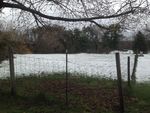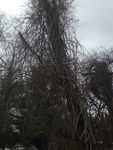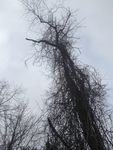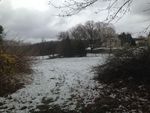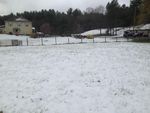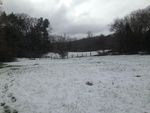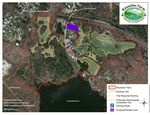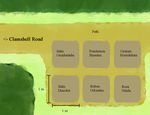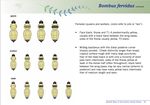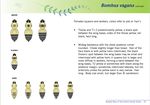Native Pollinator Conservation at Rauscher Farm: Project Report
←
→
Page content transcription
If your browser does not render page correctly, please read the page content below
Native Pollinator Conservation at
Rauscher Farm: Project Report
______________________________________________________________________________
Interdisciplinary Qualifying Project
This report represents the work of one or more WPI undergraduate students submitted to the
faculty as evidence of completion of a degree requirement. WPI routinely publishes these reports
on the web without editorial or peer review.
Worcester Polytechnic Institute
Fall 2020 - Spring 2021
By:
David Chen
Joy Tartaglia
06 May 2021
Professor David I. Spanagel
Department of Humanities & Arts1
Table of Contents
Table of Figures 3
Abstract 4
Acknowledgements 5
Executive Summary 6
1. Introduction 8
2. Background 11
2.1 Brief History of Rauscher Farm 11
2.2 Biodiversity and Bees 11
2.2.1 Difference Between Bumblebees and Honey Bees 12
2.2.2 Bombus fervidus and Bombus vagans 13
2.2.2 Bumblebee Lifecycle 14
2.3 Factors Contributing to Pollinator Declines 15
2.3.1 Habitat Loss and Fragmentation 16
2.3.2 Agrochemicals 17
2.3.3 Alien Species and Competition 17
2.3.4 Diseases 18
2.3.5 Climate Change 18
2.3.6 Impacts of Pollinator Declines 19
2.4 Public Awareness and the Beecology Project 19
3. Methodology 22
3.1 Interviews 22
3.1.1 Experts 23
3.1.2 Site Visit 23
3.2 Pollinator Garden 23
3.2.1 Objectives for Pollinator Garden Planning 24
3.2.1.1 Native Pollinators 24
3.2.1.2 Plant Selection 25
3.2.1.3 Location Requirements 25
3.3 Rauscher Farm’s Habitat Maintenance 26
3.4 Methods for Raising Public Awareness 26
4. Results 28
4.1 Ecological Relationships 282
4.2 Pollinator Garden Plans 31
4.2.1 Design 31
4.2.2 Plants 32
4.2.3 Location 33
4.2.4 Management 34
4.2.5 Public Awareness 35
5. Concluding Thoughts 36
5.1 Project Reflection 36
5.2 Limitations 37
5.3 Future Work 37
6. Bibliography 39
Appendix A: Interview Transcripts 43
Gegear Interview Transcript 43
Morris Interview Transcript 52
Appendix B: Plant List Selected for Rauscher Farm 56
Early Bloom time (March - May) 56
Mid Bloom Time (June - July) 57
Late Bloom Time (August - October) 58
Appendix C: Photos of Rauscher Farm 593 Table of Figures Figure 1. Identification Chart for Bombus vagans (Colla et al., 2011, p. 29) 13 Figure 2. Identification Chart for Bombus fervidus (Colla et al., 2011, p. 65) 14 Figure 3. Example Pollinator Garden Layout Plan 31 Figure 4. Map of Rauscher Farm (Webster 2021) 34
4 Abstract Native pollinators have been on the decline across the globe. Their role in the ecosystem provides a basis for plant proliferation and survival. However, creating a pollinator garden to help bolster native pollinator populations requires a complex and interconnected system of plants, pollinators, and maintenance. The team was tasked with researching and compiling the necessary components to create a comprehensive plan for Rauscher Farm (in Clinton, Massachusetts) to implement a pollinator garden. The team consulted with researchers as well as local conservation land managers to not only develop a stronger understanding of the problems native pollinators face, but to provide an adaptable plan for the management committee at Rauscher Farm to utilize.
5
Acknowledgements
The team would like to thank the following individuals who helped with the development
and research of this project:
● Project Advisor: David I. Spanagel, Ph.D
● Project Sponsor: Gloria Parkinson and the Rauscher Farm Management Sub
Committee
● Key Contributors: Robert Gegear, Ph.D; Matthew Morris; Freddie C. Gillespie
The team would especially like to acknowledge Dr. David Spanagel for his guidance and
support in the team's planning and research, as well as with deliverables. The team would also
like to give thanks to Gloria Parkinson and the RFMSC for their assistance and guidance with
site visits and consultations on the project. We would also like to recognize Matthew Morris of
the Native Pollinator Task Force and Freddie Gillespie of Breakneck Hill for the insight and
knowledge they provided with their experience for our project. Furthermore, the team would like
to recognize and give thanks to Dr. Robert Gegear for his outstanding continued work in the
pollinator field as well as his generous assistance with our project through his lab’s data and
work.6
Executive Summary
Native bumblebees like Bombus fervidus and Bombus vagans are a crucial component of
native ecosystems. Not only do they provide the key ecological service of pollination for native
plant species, but they also interact and comprise a more complex plant-pollinator system that
allows for the proliferation of native plants that contribute to other key species native to
Massachusetts. Loss of habitat is the primary contributing factor to native bee species decline.
The primary goal of pollinator gardens is to reintroduce at-risk or missing plant species back into
the land. However, careful consideration and planning must be taken not only in what species of
plants to include, but also regarding the location of the garden, as well as the larger ecological
system within which the garden will be located.
To better understand the issues that plague native bee species, the team sought the
expertise from local experts in the field of bee ecology. Following the guidance of the project
sponsor Gloria Parkinson, the team corresponded and interviewed with Dr. Robert Gegear. The
team aimed to confirm our initial research as well as fill in any gaps in our knowledge on native
pollinator conservation. The primary takeaway was a shift in our focus from specifically
bumblebees to a wider ecological system. The second interview the team conducted with
Matthew Morris of the Native Pollinator Task Force echoed many of the key points noted by
Gegear.
From these interviews the team began further research into the areas highlighted by both
Gegear and Morris. Primarily, the team split attention into two areas. First, we analyzed Gegear’s
established native pollinator plant list and determined what species could be added to
complement the existing wildlife at Rauscher Farm. Our selections took into account both our
preliminary research as well as what we learned from the interviews with both Gegear and7
Morris. The team needed to consider nectar sources, pollen sources, as well as host plants for
bumblebee, butterfly, and bird species. Furthermore, there needed to be pollen and nectar sources
throughout the entire blooming season (from March to October). Second, the team searched for a
local botanist/conservation land manager to gain insight on the process of starting and
maintaining a pollinator garden. Morris suggested Frederica Gillespie of Breakneck Hill who has
both experience in cultivating pollinator gardens as well as maintaining conservation land.
Moreover, Gillespie worked with Gegear to study and test certain species of plants. She provided
insight into various techniques employed in cultivating new plants for a garden and informed the
team on maintenance tips in addition to issues they ran into and potential solutions. For
maintenance, she referenced the information from Gegear in respect to field mowing and
trimming, reporting success associated with a regime of yearly mowing in sections or lines to
leave certain areas still growing while cutting back others.
Overall, the team compiled the information gathered both from research as well as our
interviews and visits with experts to provide a summary of our suggestions to the sub-committee
at Rauscher Farm. We provide a proposed location to plant the garden as well as a layout for the
garden’s structure. Furthermore, the team delivered an initial plant list to provide the necessities
required for a comprehensive pollinator garden based on Gegear’s established plant list for plant
species native to central Massachusetts.8
1. Introduction
Humans have influenced the global ecosystem and climate in a way that negatively
affects our lives and futures (Myers et al. 2013; Myers and Patz 2009; Martens et al., 1997).
From steadily rising global temperatures to loss of agricultural sustainability, a host of issues
threaten the longevity of our current society. One issue is an underlying concern about the
decline of pollinators that contributed to our current situation.
The importance of pollinators and their decline has been a growing concern among
researchers (Palmer et al., 2004; Klein et al., 2007; Ricketts et al., 2008; Potts et al., 2010).
Heightened awareness of the issue has brought about new national and international biodiversity
assessments, monitoring initiatives, and action plans. . Insects, most notably bees, play an
essential role in the majority of terrestrial ecosystems; providing the ecosystem services
necessary for both agricultural productivity (Klein et al., 2007; Ricketts et al., 2008) and
maintenance of wild plant habitats (Ashman et al., 2004; Aguilar et al., 2006). The ecological
services the bees and other pollinators (butterflies and birds) provide (and their vulnerability) has
been well understood by researchers for some time (Palmer et al., 2004). Overall, the loss of
habitat is the most crucial factor in the decline of bees (Potts et al., 2010). Furthermore, the
decline of bees and the decline of suitable habitats for pollinators are intertwined in an
unfortunate negative feedback loop. The decrease of habitats reduces the population of
pollinators able to bolster the viability of habitats, resulting in further loss of habitats for
pollinators.
A variety of means have been implemented in the effort to combat the decline of
pollinators. Just over the last half-century landmark policies have been passed as well as
foundations and agencies being created to protect pollinators. For example, the National9
Resources Conservation Service (NRCS) of the United States Department of Agriculture since
2014 has been making efforts to bolster the states where two-thirds of the pollinators migrate to
during the summer; enhancing around 35,000 acres of land. More efforts include international
non-profit organizations like the Xerces Society founded in 1971 to research and protect
endangered invertebrates. Other means include more localized efforts like pollinator gardens and
habitat maintenance that have shown to be effective means for local revitalization of pollinator
habitats (Fukase & Simons, 2015, p. 304-305; Eubanks et al., 2019; Baldock, 2020).
Nonetheless, pollinators are still on the decline and crop food viability and sustainability
continue to fall.
In the past decade, focus has shifted from pollinators to pollinator systems. Pollinators
are meaningless unless there are plants involved. Moreover, research began concentrating on the
diversity of plants and their generalized use among pollinators (Johnson & Steiner, 2000; Sahli &
Conner, 2006). Furthermore, researchers heightened focus on the entire ecosystem in respect to
pollinators (Saunders et al., 2015). Studies have found conflicting results with flower and plant
visitation from pollinators. General understanding until recently has been that the majority of
angiosperm flowers are specialized for pollination by a specific pollinator (bees, butterflies, or
birds). With the advent of more ecological system focused pollinator research, more studies
observe widespread generalization in pollinator systems, especially in non-tropic ecosystems
(Johnson & Steiner, 2000; Sahli & Conner, 2006).
However, within the general population, individuals are often intimidated when faced
with the scope of the global issue. Many still lack knowledge on pollinators and the plight they
face. As a result, it is difficult to garner public support and interest in bees and other pollinators
as public opinion of these pollinators are typically negative and fearful (Schönfelder & Bogner,10
2017). Educating the general population yields the best means for combating pollinator decline
(Marselle et al., 2020).
Rauscher Farm began with a public campaign from the town of Clinton to purchase the
land for a recreational environmentally managed open space. From its conception as a public
park and education platform, it has run numerous volunteer and education programs to educate
the general public. When lobbying for the purchase of Rauscher Farm during the mid to late
2000s, emphasis on pollinators was not a key vision for the plot of land in Clinton
Massachusetts. However, Rauscher Farm’s sixty-two acres of open fields, woodlands, and
wetlands were deemed worth protecting by the people both for their betterment in the short term,
as well as the long term. Harking back to the widening body of research, pollinators, specifically
bees, are an essential cornerstone in maintaining a sustainable ecosystem (Aizen et al., 2009;
Gallai et al., 2008; Potts et al., 2010; Hallmann et al., 2017; Coache et al., 2018; van Klink et al.,
2020). Rauscher Farm has a vision of providing a better long-term future for the residents of
Clinton that resonates deeply with the ongoing conservation movement surrounding pollinators
and global sustainability. In addition, it provides an avenue to better enhance and understand
habitat conditions for pollinator species as a field “laboratory”. Finally, the farm stands as a
platform for educating the general public about an essential cornerstone in the ecological
services we all depend on for the food we eat.
At Rauscher Farm, the team has three project goals: to devise plans for a pollinator
garden and habitat maintenance, to perform a meta-analysis regarding the intricacies related to
balancing pollinator habitats within the existing ecosystem on the farm, and to recommend
avenues for the farm to provide an enriching educational experience to the general public.11
2. Background
2.1 Brief History of Rauscher Farm
Rauscher Farm contains approximately 62 acres of fields, forest, and wetlands, and
includes part of the shore of Clamshell Pond. It was a family farm for generations, but in 2006
the land became available for purchase and a real estate developer proposed to convert the farm
into a large residential development. In response to a vigorous group of citizens’ efforts to
forestall that plan, the town voted to purchase the farm in 2008 through a bond after a successful
campaign that marketed Rauscher Farm as one of the last large open spaces the public could
enjoy. The Clinton Conservation Committee created the Rauscher Farm Management
Subcommittee to maintain and protect the farm. Currently, Rauscher Farm is open to the public
and frequently hosts events to attract and inform visitors and volunteers to connect with and
enjoy what nature has to offer. One of the RFMSC’s focuses is the conservation of pollinators.
2.2 Biodiversity and Bees
Bees are among the most important pollinators, both in agriculture and in the ecosystem.
They pollinate 80% of wild plant species, 66% of the world’s cultivars, and 75% of agricultural
crops used directly for human food (Heather et al., 2017, p. 5). Since different bee species
pollinate different plants, the diversity of plants relies on the diversity of bees. Likewise, the
diversity of bees relies on the diversity of the plants available. Other animals and insects also
rely on plants which depend upon bee pollination.12
2.2.1 Difference Between Bumblebees and Honey Bees
Two types of the many types of bees are honey bees, Apis, and bumblebees, Bombus.
These two bees differ greatly in their lifecycle and behavior. Honey bee hives can have tens of
thousands of bees and colonies live for a long time. Since they have to last through winters, they
create excess amounts of honey in preparation and this is what makes them ideal for
domestication. Bumblebee hives are much smaller with up to a few hundred bees depending on
the species, and their nests do not survive the winter so the amount of honey they produce is only
just enough to support the hive for a short time. They can also sting more than once, unlike
honey bees, but bumblebees will only sting when truly provoked and they do not swarm like
honey bees.
Bumblebees are also more resistant to bad weather such as cold and rain, and they can
forage in cooler temperatures and with limited light conditions. They are not as integral to
agriculture as honey bees, but they are able to perform “buzz pollination” where the bee
dislodges trapped pollen by vibrating its wing musculature. Plants such as tomatoes, peppers, and
cranberries benefit significantly from buzz pollination (Xerces Society, n. d.).
Lastly, concerns over honey bee declines are due to the significance of their pollination
services in agriculture. They are not native to North America so they are not significant to the
native ecosystem. Bumblebees are native to North America, and in Massachusetts there are ten
species. The two species that are relevant to this project are Bombus fervidus and Bombus vagans
which can be distinguished by their distinct coloration patterns.13
2.2.2 Bombus fervidus and Bombus vagans
The half-black bumblebee, Bombus vagans, has a medium tongue length, nests on the
ground and underground, and has been observed foraging in heavily shaded areas within forests
(Colla et al., 2011, p. 26). The head, thorax, and part of the abdomen are mostly yellow and the
rest of the abdomen is black. Its appearance can be confused with Bombus sandersoni, Bombus
perplexus, Bombus impatiens, and Bombus affinis. The half-black bumblebee has been observed
foraging from Penstemon (Beardtongues), Asclepias (Milkweed), Asters, Cirsium (Thistles),
Eupatorium, and Spirea (Meadowsweet).
Figure 1. Identification Chart for Bombus vagans (Colla et al., 2011, p. 29)14
The yellow bumble bee, Bombus fervidus, has a long tongue length, nests on the ground
and underground, and has been observed in open fields and meadows (Colla et al., 2011, p. 62).
They are predominantly colored yellow with some black on their thorax and abdomen. Its
appearance can be confused with Bombus borealis. The yellow bumble bee has been observed
foraging from Lonicera (Honeysuckle), Cirsium (Thistle), Trifolium (Clover), Penstemon
(Beardtongues), and Lythrum (Loosestrifes).
Figure 2. Identification Chart for Bombus fervidus (Colla et al., 2011, p. 65)
2.2.2 Bumblebee Lifecycle
In early spring, queens wake up from hibernation and search for a nest site such as a hole
in the ground or a tussock of grass. Once the queen finds a location, she collects pollen and lays15
eggs. Larvae hatch after several days and the queen feeds them by continuing to collect pollen
and nectar. It takes about four or five weeks for the first eggs to emerge as adult workers. These
workers are female and they live for one to two months. Throughout early summer, they continue
to forage for nectar and pollen while the queen remains at the nest to lay eggs for more workers.
Late summer, the nest will produce new queens and male drones who leave the nest to mate. The
mated queens forage to prepare for hibernation and they overwinter underground. The old nest
dies out and is not reused. When spring comes again, the hibernating queens emerge to repeat the
cycle (Xerces Society, n.d.).
2.3 Factors Contributing to Pollinator Declines
The decline of pollinators, particularly bees, has been a growing concern in agriculture
and for wild plant and pollinator diversity. The domesticated honey bee stocks have been
declining in certain regions, causing concern about the future of honeybee pollination services
for agricultural crops that depend on a single species. The beekeeping industry is declining in the
USA, and most wild and feral honey bee colonies in the USA have disappeared. As of 2010, the
best documented pollinators are bumblebees and butterflies, but data on other pollinators are
lacking (Potts et al., p. 346). Native North American bumblebee species have declined in
abundance by up to 96%, and geographic range from 23-87% (Levasseur et al., 2018, p. 5).
Currently, the suspected causes of bumblebee decline are habitat loss, agrochemicals, alien
species, diseases, and climate change. The generalized concept of pollinator declines does not
mean all species are on the decline, especially in respect to native ecosystems and habitat loss.
Specifically, although honey/managed bees are essential for the agricultural side of pollinator
protection, when focusing on native ecosystems, honey/managed bees play no role as non-native16
species of bees. The key is access to the necessary native plants for the pollinators native to that
ecosystem. Certain pollinators prefer certain species of plants, and thus the plant is just as
important as the animal when referring to pollinator decline. Moreover, bees specifically require
both nectar and pollen to survive and reproduce. Nectar acts as a source of energy, and pollen as
a source of protein. Critically, bees cannot reproduce without pollen. Therefore pollinators must
have access to both nectar and pollen bearing plants. Pollinators are not pollinators until they
help the plant reproduce, and with the decline of key native plants, re-establishing the connection
between native plants and pollinators is the priority as the building blocks of ecosystems.
2.3.1 Habitat Loss and Fragmentation
The loss of habitats for bees is considered by many experts and advocates to be the
primary reason for their decline. Land conversion for infrastructure or agriculture removes and
fragments habitats, and less space means fewer resources and fewer locations to nest. Fewer
floral resources means less food for bees, and lack of nesting habitats fragments bee colonies.
“Several studies” have shown that certain bee species can tolerate moderate habitat loss because
bees are mobile and have adapted to using patchy resources (Potts et al., 2010, p. 349). Urban
settings also may present locations for certain bees to nest, but overall, the effects of urbanization
require more investigation and not all types of bees can adapt to the loss of their habitat.
Fragmentation of bee colonies occurs with the loss of the nest and habitat, and with a colony split
into smaller parts there aren’t enough bees to ensure survival.17
2.3.2 Agrochemicals
The expansion of agriculture has also led to the increased usage of agrochemicals which
can pollute nearby habitats and directly affect bees. Herbicides and fertilizers can decrease floral
resources that bees rely on, and insecticides can kill bees directly through intoxication, leading to
a decline in bee diversity and abundance. Pesticides are assessed for their effects on honey bees
without consideration for other species of pollinators and have been shown to have effects on the
long term survival of other pollinator populations. In the case of bumblebees, pesticides affect
the memory of bumblebees and, when the bees’ memories of the flowers they prefer are
impaired, they fly to random flowers and cross pollinate, preventing flowers from reproducing
(Heather et al., 2017,p. 9-10). More evidence of the effects of agrochemicals on bees can be
found in a comparison between fallow strips next to organic and conventional wheat fields. Both
the adjacency to organic fields and the proportion of the farmed landscape significantly increased
bee diversity and abundance (Potts et al., 2010, p. 349-50).
2.3.3 Alien Species and Competition
Some invasive species of plants that flower can provide an additional source for pollen
and nectar in the event of a shortage due to environmental change; however, the negative effects
of invasive species of plants on native plants generally outweigh the positive effects which are
limited to generalist pollinators (Potts et al., 2010, p. 350). Invasive plants disrupt and displace
native species, and the decline of native plants is detrimental to pollinators who prefer certain
plants or are specialists. Left unchecked, invasive plants that attract generalist pollinators will
continue to spread, increasing competition with native plants for space and resources and quickly
worsening their indirect influence on other pollinators who rely on the native plants.18
The honey bee itself is not native to North America, and there is evidence that
domesticated honey bees can harm biodiversity through competition, pollination of invasive
plants, the spread of pathogens, and direct interactions. Honey bees make use of the same
resources as bumblebees, so the presence of domesticated honey bees reduces the pollen and
nectar available for native species. As generalists, they also aid in the spread of invasive plants
through pollination. Pathogens and parasites can also be passed from translocated honey bees to
endemic bumblebees. Lastly, some managed honey bees can interbreed with endemic
bumblebees, reducing genetic diversity of native bees or even eliminating subspecies (Potts et
al., 2010, p. 350).
2.3.4 Diseases
Disease is another cause for concern on the decline of both honey bees and bumblebees,
especially because pathogens can be passed from one to the other. One example is the deformed
wing virus which is spread by mites. Though it originates in honey bees, it can infect other bee
species and data suggests the virulence of the virus is higher in bumblebees (Potts et al., 2010, p.
350). Translocated alien bees increase the risk of various pathogens being spread to native
populations, and other factors such as climate change, land-use change, pesticides, or lack of
resources might also increase susceptibility to pests and pathogens, or vice versa.
2.3.5 Climate Change
The effects of climate change on pollinators are predicted to have a severe impact on
pollinators in the future. Both bees and plants rely on the weather as seasons change, and if
weather patterns and temperatures change then bees and plants may become out of sync. The19
blooming time of flowering plants may be affected. Bees need a steady supply of pollen and
nectar because they do not stockpile their resources, and if there is an extended gap of time
between available resources, colonies will lack sources of food and will be in danger of dying.
2.3.6 Impacts of Pollinator Declines
A decline of honey bees threatens commercial agriculture, and therefore threatens our
economy and major source of food. A majority of all crops used directly for human food
worldwide rely on insect pollination that is primarily bees, and although there is still an average
yield increase over time, the increase is due to the use of commercial pollinators where honey
bees are rented to pollinate crops (Potts et al., 2010, p. 347).
Bumblebees, on the other hand, are important to the ecosystem. A healthy ecosystem is
biodiverse, and bumblebees are not the only pollinators. Butterflies, flies, and birds are also an
integral part of the pollination system. Unfortunately, the decline of the diversity of pollinators
perpetuates itself. The decline of pollinators will inevitably lead to the decline of the flowering
plants and crops that depend on them. The decline of the flowering plants, particularly wild
native plants, likewise leads to a decline in the diversity and abundance of the pollinators that
rely on them. In addition, other animals and insects that rely on the plants will also be negatively
affected and will lead to the collapse of the ecosystem, a drastic decline in biodiversity.
2.4 Public Awareness and the Beecology Project
The decline of pollinators is not a problem any person can solve alone, so it is important
to raise public awareness to inform people and encourage their involvement. Two challenges in
efforts to conserve pollinators is spreading awareness and engaging the public in aiding scientists20
in their research. The international Xerces Society for Invertebrate Conservation is one example
of a non-profit organization whose purpose is to conserve invertebrates and their habitats while
also offering a library of research and resources anyone can use. Another example based in
Massachusetts is the Metrowest Conservation Alliance (MCA) Native Pollinator Task Force
(NPTF) which includes members from the Southborough Open Space Preservation Commission,
Sudbury Valley Trustees, Lincoln Land Conservation Trust, Marlborough Conservation
Commission, and Concord Pollinator Health Advisory Committee (Sudbury Valley Trustees
2021).
In addition to their work to conserve pollinators, the NPTF also promotes the work and
research of Dr. Robert J. Gegear, a biology professor at UMass Dartmouth whose research
focuses on pollinators in Massachusetts, particularly bumblebees. Dr. Gegear compiled a list of
plants based on his field research on the interactions between bumblebees and other native
pollinators with those plants, creating a list of recommended plants for pollinator gardens
(Gegear 2019). His list has largely influenced the conservation efforts of the NTPF as well as
our research into the conservation of pollinators at Rauscher Farm.
Another resource created by Dr. Gegear working with an interdisciplinary team is the
Beecology Project. The project is a web application designed to teach the public about
bumblebees and the importance of native pollinator diversity, and to act as a platform through
which citizen scientists could contribute data for visual analysis (Levasseur et al., 2018). Any
person could become a citizen scientist for the Beecology Project by learning how to identify
bumblebees and their behaviors around flowers and then log bumblebee sightings on the
Beecology Project web application. Through applications such as the Beecology Project and21 through organizations such as the NTPF, the public can become more aware of the decline of native bumblebees and learn what they can do to conserve them.
22
3. Methodology
In this section, the team details our project objectives, approaches, and the criteria we
applied for gathering materials as well as methods for testing and data collection. Working
closely with Professor Spanagel and the members of the RFMSC we examined various means to
bolster native pollinator habitation and educational services to the public at Rauscher Farm. The
primary source of existing information utilized by the team comes from the research of Professor
Gegear and his lab. Prof. Gegear has extensive experience and knowledge of native pollinators as
well as a comprehensive collection of keyplants and ecological interaction that acted as the basis
of our research and planning.
3.1 Interviews
The team conducted interviews with pollinator researchers as well as experienced
botanists local to Worcester to gather beneficial insight into creating a pollinator garden. In
particular, we sought the advice of Dr. Robert Gegear for his extensive research and experience,
as well as others with experience for creating a pollinator garden. Interviews were scheduled and
conducted over Zoom due to the current COVID pandemic. The most important questions we
asked were designed to convey our project’s purpose and importance, to learn how to maintain a
habitat to support the bees in decline, specific details and advice for garden plans, and to acquire
some practical understanding and appreciation for the scope of the physical labor required.
Another aspect of our interviews was to inquire about other resources and experts we could
contact for more information.23
3.1.1 Experts
To find additional experts, the team began by looking for other researchers and
practitioners who were utilizing Dr. Gegear’s research. We learned about and contacted Matthew
Morris of the Native Pollinator Task Force, however Morris was an event organizer and had
limited first hand experience in making pollinator gardens. He instead recommended that we get
in touch with Frederica Gillespie who had experience in creating a pollinator garden at
Breakneck Hill in Southborough, MA.
3.1.2 Site Visit
We also wanted to visit an established pollinator garden site to examine as an example for
our plans. It was also important for us to visualize the physical dimensions and configuration of
the garden we were planning. We asked for pollinator garden locations in our interview with
Matthew Morris and were told about a location in Lincoln, Massachusetts. We instead chose to
visit Breakneck Hill in Southborough, Massachusetts because it was closer to Worcester where
the team resides and because we wanted to contact Frederica Gillespie for her experience in
planting a pollinator garden.
3.2 Pollinator Garden
Pollinator gardens are the primary method shown to improve local pollinator population
and habitation (Fukase & Simon, 2015, p. 304-305; Eubanks et al., 2019; Baldock 2020).
Pollinator gardens are typically defined as a plot of land with a diverse set of beneficial
vegetation for pollinators. A pollinator garden allows for safe habitation for pollinators24
(dependent on the types of flowers and plants in the garden) and provides a natural aesthetic for
public parks like Rauscher Farm.
The diversity of plants that compose the pollinator garden are certainly the most
important factors to consider when planning a pollinator garden. However, there are a multitude
of other factors that needed consideration. Components of a pollinator garden we considered are
compiled and detailed below.
3.2.1 Objectives for Pollinator Garden Planning
3.2.1.1 Native Pollinators
The primary focus of the garden is to bolster native pollinator populations. Therefore, the
team started by researching the plight of native pollinators. At the start the team thought the
honey and other managed bee species were part of this category, but quickly learned our focus
would be on two specific species of bumble bees. To better understand both the needs and threats
of native pollinators, the team contacted experts on New England plant and pollinator ecology.
The project sponsor, Gloria Parkinson directed the team to Professor Robert Gegear because of
his previous work with Rauscher Farm as well as his extensive research into native pollinator
species, especially bees. In conjunction with contacting Prof. Gegear, the team looked into other
researchers utilizing Gegear’s lab’s data and recommendations about ecological systems. The
NPTF is one organization using Dr. Gegear’s research, so we contacted Matthew Morris who is
an event organizer. We also learned about WPI’s involvement with the Beecology Project. Our
investigation shifted the team’s attention away from the narrow focus on bees to a greater
awareness of the dynamic system in which plants and pollinators act out their role in the larger
ecosystem.25
3.2.1.2 Plant Selection
The next criterion for the pollinator garden the team considered was the types of plants.
The first area the team investigated was how to select the types of plants to have in the garden.
Per our talk with Prof. Gegear, the team focused on native plants at risk. The team
cross-referenced with Gegear’s native pollinator plant and other information sources (Xerces
Society plant database; Mass Audubon, and Freddie Gillespie of Breakneck Hill), and compiled
a list of at risk native plants that are known benefactors for the two species of bumble bee we
aim to bolster. Our last criterion for plant selection was whether the plants benefited other
pollinators besides the target bumblebees as well as talked to individuals who had experience
tending to conservation land. We accounted for the larger ecosystem and plant pollinator system
described by both Gegear and Morris and wanted to ensure we were not overlooking issues
already documented (rampant growth and species choking out other native species) that other
conservation land had experienced.
3.2.1.3 Location Requirements
Two locations on Rauscher Farm were suggested to us to begin with, and we evaluated
them and other potential locations for the pollinator garden. There were many important factors
to consider when choosing any prospective location. Most obvious was the space requirement.
There needed to be enough room for the square meter grid, including space for paths in between.
The location also had to be accessible, with particular attention given to travel distance and
available sources of water for the garden. In addition, the garden should also be in a location
with low risk of environmental damage such as erosion, and it should be kept away from
encroaching invasive species. The type of soil and amount of shade are also important factors to
consider about the location because it affects what plants will grow best. Lastly, for bumblebees,26
it is very important for the garden to be relatively close to preferred nesting sites due to the
bumblebees’ limited range.
3.3 Rauscher Farm’s Habitat Maintenance
The team designed a comprehensive guideline for habitat maintenance at Rauscher Farm
as a plan to be used in conjunction with the pollinator garden or as an alternative for the garden.
Through our research on and off the farm, the team gathered and analyzed data on the current
state of the farm. The data the team aimed to collect and analyze is outlined below:
- Catalog of existing plants beneficial to pollinators on the farm
- Soil composition and measurements
- pH, Salt content, Nitrate/Nitrites
The primary goal of this guideline is broken into two elements. The first is to provide a
quantitative and qualitative analysis of Rauscher Farm to assess ways to better provide for native
pollinators through the regular maintenance of the property. Through our research and analysis of
data outlined above, we compiled a plan/guideline for the maintenance crew at Rauscher Farm
with edited means of maintenance to better accommodate native pollinators.
3.4 Methods for Raising Public Awareness
The team examined the methods used by the farm currently as well as methods used by
other organizations and projects to decide what events and resources would be most useful in
raising public awareness on the decline and conservation of pollinators. Rauscher Farm has held27 a number of events promoting the education of pollinators, and the most recent event featured Dr. Gegear in 2019. The NPTF hosts webinar events to inform the public on how to conserve native pollinators, and the Xerces Society offers a library of research and information on their website. Dr. Gegear’s Beecology Project also provides an opportunity to educate and engage the public.
28
4. Results
4.1 Ecological Relationships
The primary information gathered from both our visits to local conservation lands, as
well as our interviews with experts in the field has led us to careful consideration of the
ecological relationships and systems at play when creating a pollinator garden (Gegear, 2021;
Morris, 2021). Foremost, our aim is to provide a habitat to bolster the populations of at-risk
native pollinators, namely Bombus fervidus and Bombus vagans. However, the critical
connection between varying trophic levels in the ecological system at Rauscher Farm must also
be considered (Gegear, 2021). Although both species of bumble bee are the target, other
pollinators and members of their ecological system must be accounted for. The focus shifts from
pollinator decline to restoring the ecological niche that they account for, as well as the other
members that contribute to that niche. Gegear specifically prefers to refer to this issue as
“pollination systems” instead of the pollinator problem because the term pollinators is
meaningless unless there are plants involved. Plants are what are being pollinated; pollinators
like bees and butterflies are simply flower visitors, or more specifically, nectarivores and
pollenivores. They do not become pollinators until they benefit the plant by helping them
reproduce (Gegear, 2021). Therefore, bolstering native bumble bee populations requires a more
comprehensive effort to restore native plant species that have been in decline or contention from
other invasive plants. In essence, conservation of pollinators should not focus exclusively on
bumble bees, but instead should restore the connection between native pollinators and their29
respective native plant matches as the crucial building blocks of ecosystems. Moreover, the
relationship between plants and pollinators is extremely complex.
A diverse set of considerations must be examined when creating a habitat for native
pollinators. Although endangered bumble bee species are the focus, butterflies and birds are
deeply connected with the plants supporting those at-risk species (Gegear, 2021). For example, at
the larval stage, butterflies are a primary food source for birds, in turn, the birds provide the bees
service by keeping pest insects that prey on the bee eggs at bay. However, host plants for these
butterflies must not be allowed to infringe on the tall grass needed for nesting by the bees and
other bird species. Monarch butterflies specifically require milkweed to hatch larvae on.
However, besides acting as a host plant, the milkweed is not a source of pollen or nectar for
butterflies or native bees (Gillespie, 2021). In addition to balancing both the species of plants and
their role in terms of the various trophic levels, it is also critical to select plants based on their
usage.
Bees, and pollinators in general require access to three main sources from plants; nectar,
pollen, and habitation. Nectar acts as an energy source for bees. Moreover, nectar is a source of
energy for other pollinators like butterflies and certain birds. Next, pollen provides a source of
protein for reproduction. For bees, pollen allows for reproduction and without pollen, regardless
of if they have a nectar source for food and energy, they will not be able to reproduce (Gegear,
2021). Furthermore, the bees are actively seeking nectar whereas the pollen is collected passively
as a result of seeking nectar for energy. Therefore, there must be both an even composition of
nectar and pollen plant sources in the garden. Finally, there must be an available habitat for the
bees and other pollinators to nest safely. Certain species have requirements. For example,
Monarchs require milkweed as a host plant, but not as a food source (Agrawal, 2017). Bumble30 bees mainly nest in fields that include tall grass and trees. Crucially though, this nesting area must be in close proximity to the necessary nectar and pollen sources (around 50 meters). In order to guard against the dangers of pollinator hyperspecificity, the focus of the garden, its location, and its plant composition must not solely be tailored to the bumble bee species in decline as it may be detrimental to the other necessary wildlife in the ecosystem.
31
4.2 Pollinator Garden Plans
4.2.1 Design
Figure 3. Example Pollinator Garden Layout Plan, featuring pollen and nectar sources from Mar to Sept,
based on the location detailed in 4.2.3 Figure 4 and using the Plant List in Appendix A
Based on our observations and conversations with the several experts that we consulted,
our recommended layout for the garden is a 1x1 square meter grid with space for paths in
between. These dimensions are recommended and currently assumed to be the best practice.
According to Matthew Morris, it has not been fully researched yet, but it is important to have at32
least a square meter of blooms per season. Each square should include only a single plant with
sufficiently high density to ensure that it can both outcompete any other native or exotic plant
that might also take advantage of the cleared space and ensure it will attract pollinators.
4.2.2 Plants
Deciding what species of plants to use in a pollinator garden requires complex
calculations and planning. Foremost, soil composition and conditions (pH, salt content,
nitrate/nitrite content) need to be ascertained and cataloged to determine what plants are viable
based on the available land at Rauscher Farm. Other factors to consider are bloom time and
costs. Another important consideration is the size of land being dedicated for planting. Based on
our interviews with experts (Gegear, 2021; Gillespie, 2021; Morris, 2021) we found a one meter
by one meter square plot for one specific plant is the minimum for an ideal pollinator plant
system. Moreover, there should be space in between each squared section for a walkway for
visitors as well as maintenance. Therefore, a relatively large area needs to be planted to achieve
the necessary diversity for both pollen and nectar providing plants. Another factor in the number
of plants to place is bloom time. Per our expert sources, there should be at least one nectar and
pollen source per bloom season, from the first snowmelt to the first hard frost (Essentially from
March to October). Furthermore, when choosing plants, the wildlife attracted by those plants is a
critical factor the team found needed consideration. Obviously what pollinators the plant
benefits is at the forefront of decision making. However, keeping track of potential pest insects
and invasive species also attracted to the plant is crucial in keeping Rauscher Farm a native
conservation sanctuary. The importance of using native plants and avoiding non natives and
cultivars. Sometimes the plants in decline are driving the decline of a species of pollinator.33
Lastly, we needed to consider which pollinator species prefers which plants to select plants
favored by multiple different pollinators in order to encourage and support ecological diversity.
In Figure 3, we chose the six plants based on our recommended plants list in Appendix B.
The plants selected for the example are sources of pollen and nectar. Salix occidentalis and Salix
discolor bloom in March and April. Penstemon hirsutus and Rubus odoratus bloom May, June,
and July. Cirsium horridulum and Rosa nitida bloom in June to September. These six plants
ensure that pollinators will have access to pollen and nectar from March to September. Most
support both Bombus vagans, Bombus fervidus, and butterflies.
4.2.3 Location
The team recommends the rectangular area marked in purple off Clamshell Road in
Figure 4 below. Pictures of the location can be found in Appendix C. We chose this location
because it fits the criteria outlined in the methodology. The land was relatively flat, away from
the wetlands, with plenty of space. It is also already partially fenced off, making it easier to keep
out larger animals, and it is a safe distance from areas of the farm struggling with encroaching
invasive species such as oriental bittersweet. There is not much shade, but the pollinator garden
at Breakneck Hill in Southborough also did not have any shade, so it should not be an issue. The
location is also accessible, just off Clamshell Road and close to public parking. The homes
surrounding the location are private property so water availability isn’t guaranteed, but even if
water has to be transported from another place, the location for the garden is close enough to the
road that hauling water would be feasible.
However, the team was not able to survey the farm for potential locations based on
existing plants available, nor did we consider many possible locations. We recommend the
location marked in Figure 3 based on our research on selecting a location for a pollinator garden,34
but we also suggest conducting a thorough survey of land to see if there are alternative locations
that meet the same requirements..
Figure 4. Map of Rauscher Farm (Webster 2021)
4.2.4 Management
Research showed the vast benefits of altered maintenance for pollinator habitation
(Baldock, 2020; Westerhold et al., 2018); small changes like frequency of grassland mowing,
brush clearing, and types of chemical agents used all can result in a more comprehensive native
pollinator sanctuary. Specifically, when looking at the endangered Bombus fervidus, accessibility
to tall grass each year is crucial. Moreover, if invasive species are a factor in the grasslands, more35
targeted mowing would need to be implemented to reduce the invasives while still allowing
enough tall grass for native pollinator nesting (Gegear, 2021).
4.2.5 Public Awareness
Events and online resources are the preferred existing methods to educate the public. The
team suggests the farm should consider hosting additional events to educate visitors on
pollinators and the pollination system. It would also be prudent to inform visitors about Dr.
Gegear’s Beecology Project and other resources such as the Xerces Society website. While the
team was unable to analyze and calculate the effectiveness and costs for signage, brochures, and
similar methods to educate the public, we suggest expanding the Rauscher Farm website with
information about and links to resources such as the Beecology Project, the NPTF, and Xerces
Society. Once the pollinator garden is established, the team recommends signage to allow
visitors to read and learn about the garden, the research behind it, and the resources available to
them.36
5. Concluding Thoughts
5.1 Project Reflection
At the start of the project, the team's knowledge on pollinators was sparse. Like many
people, we have been exposed to articles and new stories on the danger of declining pollinator
populations. However, our information was only partially correct and mostly mistaken.
First, there was a misconception that all pollinators were in decline and there was a
particular concern for honey bees. The team learned about the differences between honey bees
and bumblebees and that the former is not at all necessary for the stability and sustainability of
the native ecosystem. In addition, honey bees, as an invasive species, instead propagate the
spread of invasive species of plants. In order to conserve the native ecosystem, pollinators such
as the native bumblebees are important, however they are only one part of a massive
interconnected ecosystem. The plants they pollinate are equally as important.
Originally, the idea of a pollinator garden meant planting a few plants either in a
traditional garden format, or throughout the farmland. We didn’t quite understand the individual
benefits of certain plants (pollen sources, nectar sources, or host plants) assuming certain plants
were simply “beneficial” to pollinators. Moreover, the importance of plant density and location
to host sites was not something we thought we had to consider. Furthermore, the project name of
pollinator garden meant to the team a garden targeting bees. Although bees are a key species of
pollinators, the team quickly learned of the importance of establishing diverse plant-pollinator
systems rather than isolated and targeted gardens.37
5.2 Limitations
Throughout the project, the team faced limitations both from the global pandemic as well
as time constraints from the project timeline. Although the team was able to conduct interviews
and, later in the project, in-person site tours, social distancing proved an issue to meetings and
visitations. The interviews with both Professor Gegear and Mr. Morris were conducted through
Zoom and some, but very minimal, information was lost through poor connection. Although
social distancing wasn’t a major limitation, it did create difficulty in visiting local conservation
grounds. Scheduling meetings and visits needed extra consideration and approval from the site
manager to ensure both the team and the host would be safe.
A major limitation to the project was the timeline. The project ran over 3 separate terms
starting in WPI’s B-term (late October) and concluded at the end of D-term (early May). Due to
the nature of pollinator gardens and their reliance on plant bloom seasons, the project
unfortunately had two-thirds of the project over non-bloom seasons. This posed the limitation of
not being able to visit and observe active pollinator gardens or conservation land. Moreover, the
team was mainly limited to interviews to gather information at Rauscher Farm. Although the
farm is open over the winter, for the majority of the project weather conditions like snow and
rain prevented meaningful data gathering at the project site. For example, an initial criterion the
team hoped to gather was soil conditions at potential locations for the garden. However, due to
cold weather and snow, such measurements were unable to be analyzed.
5.3 Future Work
The team recommends continued research on the relationship between pollinators and
plants, such as what plants are preferred by what pollinators. Dr. Gegear’s plant list is38 continuously being refined with additional research and data, and the pollinators studied should not only include bumblebees, but also other bees and pollinators, such as butterflies, native to Massachusetts. A future project could include further field research on Rauscher Farm to study pollinators and the results of the pollinator garden. Furthermore, Dr. Gegear’s lab is developing an app to log and track bee and other pollinator sightings which can aid in the research and analysis at Rauscher Farm. Finally, we recommend such a project take place from spring to fall rather than over winter to allow for the best timeline for meaningful results.
39
6. Bibliography
Aizen, M. A., Garibaldi, L. A., Cunningham, S. A., & Klein, A. M. (2009). How much does
agriculture depend on pollinators? Lessons from long-term trends in crop production.
Annals of Botany, 103(9), 1579–1588. https://doi.org/10.1093/aob/mcp076
Agrawal, A. (2017). Monarchs and Milkweed, Princeton: Princeton University Press.
https://doi.org/10.1515/9781400884766
Baldock, K. C. R. (2020). Opportunities and threats for pollinator conservation in global towns
and cities. Current Opinion in Insect Science, 38, 63–71.
https://doi.org/10.1016/j.cois.2020.01.006
Colla, S., Richardson, L., & Williams, P. (2011). Bumble Bees of the Eastern United States.
Xerces Society, 2011:
Eisenhauer, N., Bonn, A., & A. Guerra, C. (2019). Recognizing the quiet extinction of
invertebrates. Nature Communications, 10(1).
https://doi.org/10.1038/s41467-018-07916-1
Fukase, J., & Simons, A. M. (2016). Increased pollinator activity in urban gardens with more
native flora. Applied Ecology and Environmental Research, 14(1), 297–310.
https://doi.org/10.15666/aeer/1401_297310
Gallai, N., Salles, J.-M., Settele, J., & Vaissière, B. E. (2009). Economic valuation of the
vulnerability of world agriculture confronted with pollinator decline. Ecological
Economics, 68(3), 810–821. https://doi.org/10.1016/j.ecolecon.2008.06.014
Gegear, R. (2021, Feb. 16) Personal Interview conducted via Zoom
Gegear, R. (2019). Plants for Pollinators at Risk. Gegear Lab At UMass Dartmouth.
https://gegearlab.weebly.com/plant-list.html.
Gillespie, F. (2021, Mar. 21) Personal Interview conducted on site at Breakneck Hill,
Southborough, Mass.
Hallmann, C. A., Sorg, M., Jongejans, E., Siepel, H., Hofland, N., Schwan, H., … de Kroon, H.
(2017). More than 75 percent decline over 27 years in total flying insect biomass in
protected areas. PLoS ONE, 12(10). https://doi.org/10.1371/journal.pone.018580940
Houbre, D., Marshall, J., & Kablik, J. (2020). Remarketing Rauscher Farm to the Community of
Clinton, MA. Interactive Qualifying Project report. Worcester: Worcester Polytechnic
Institute.
Johnson, S. D., & Steiner, K. E. (2000). Generalization versus specialization in plant pollination
systems. Trends in Ecology & Evolution, 15(4), 140–143.
https://doi.org/10.1016/s0169-5347(99)01811-x
Klein, A.-M., Vaissière, B. E., Cane, J. H., Steffan-Dewenter, I., Cunningham, S. A., Kremen, C.,
& Tscharntke, T. (2006). Importance of pollinators in changing landscapes for world
crops. Proceedings of the Royal Society B: Biological Sciences, 274(1608), 303–313.
https://doi.org/10.1098/rspb.2006.3721
van Klink, R., Bowler, D. E., Gongalsky, K. B., Swengel, A. B., Gentile, A., & Chase, J. M.
(2020). Meta-analysis reveals declines in terrestrial but increases in freshwater insect
abundances. Science, 368(6489), 417–420. https://doi.org/10.1126/science.aax9931
Levasseur, K., O'Connell, E., & Coache, S. (2018). The Beecology Project: Providing tools and
information to promote citizen scientist participation in solving pollinator decline.
Interactive Qualifying Project report. Worcester: Worcester Polytechnic Institute.
Marselle, M. R., Turbe, A., Shwartz, A., Bonn, A., & Colléony, A. (2020). Addressing behavior
in pollinator conservation policies to combat the implementation gap. Conservation
Biology, 35(2), 610–622. https://doi.org/10.1111/cobi.13581
Martens, W. J., Slooff, R., & Jackson, E. K. (1997). Climate change, human health, and
sustainable development. Bulletin of the World Health Organization, 75(6), 583–588.
Michener, C. D. (2007). The Bees of the World. Baltimore, MD: Johns Hopkins University Press.
Morris, M. (2021, Feb. 17). Personal Interview conducted via Zoom
Murphy, R., Heather, K., & Stevens, D. (2017). Bee-Cology: Educating the New England Area
on the Importance of Pollinator Diversity. Interactive Qualifying Project report.
Worcester: Worcester Polytechnic Institute.
Myers, S. S., & Patz, J. A. (2009). Emerging Threats to Human Health from Global
Environmental Change. Annual Review of Environment and Resources, 34(1), 223–252.
https://doi.org/10.1146/annurev.environ.033108.102650
Myers, S. S., Gaffikin, L., Golden, C. D., Ostfeld, R. S., H. Redford, K., H. Ricketts, T., …
Osofsky, S. A. (2013). Human health impacts of ecosystem alteration. Proceedings of theYou can also read
